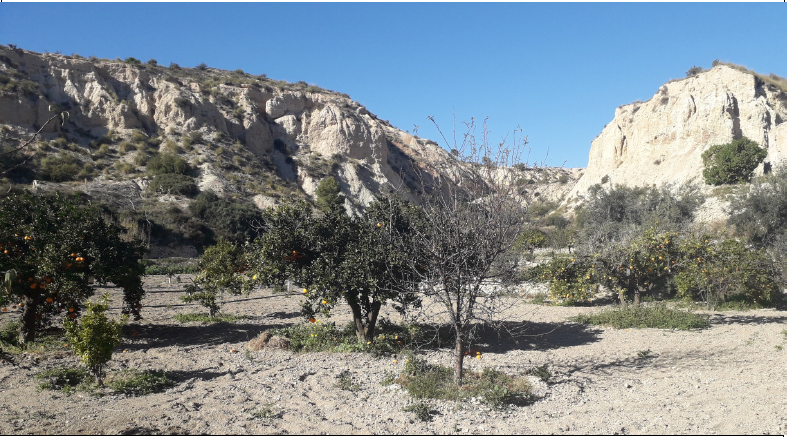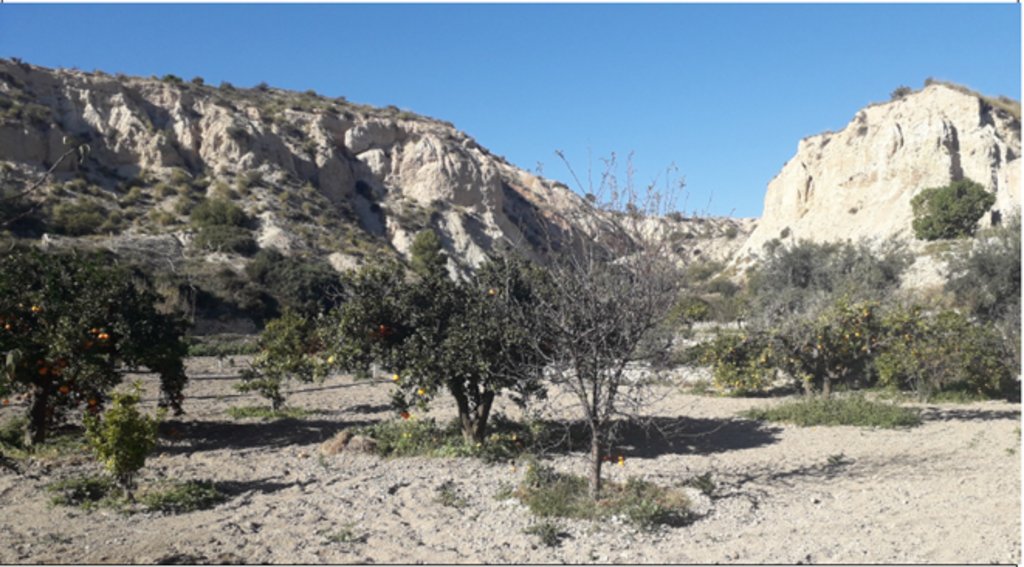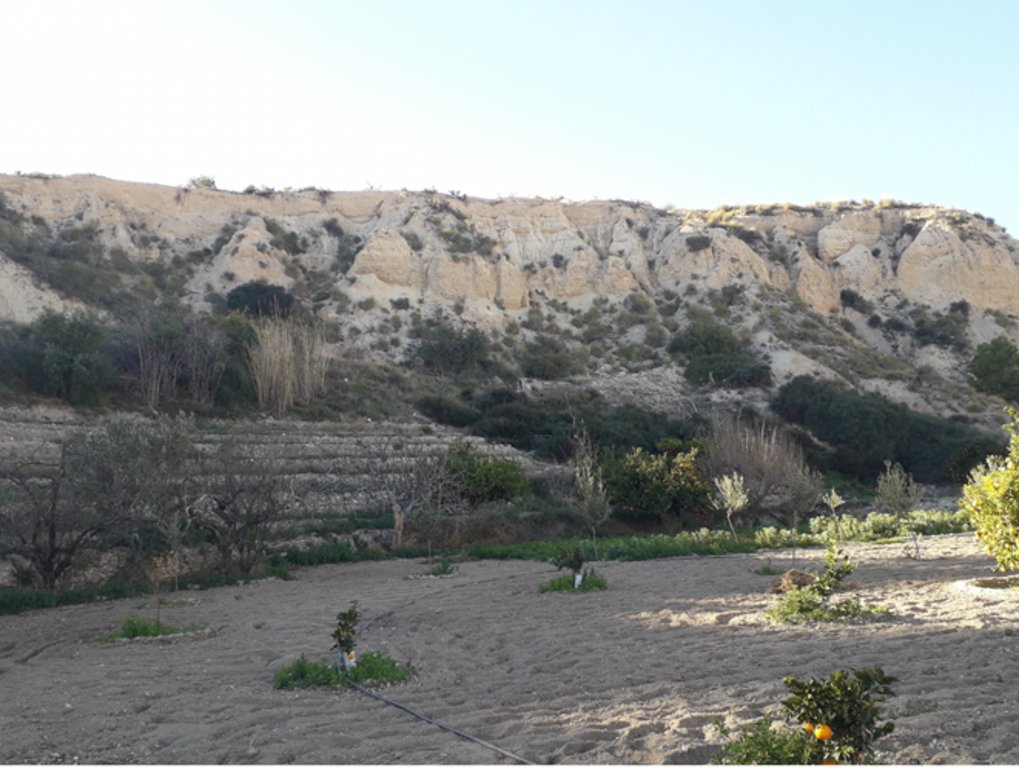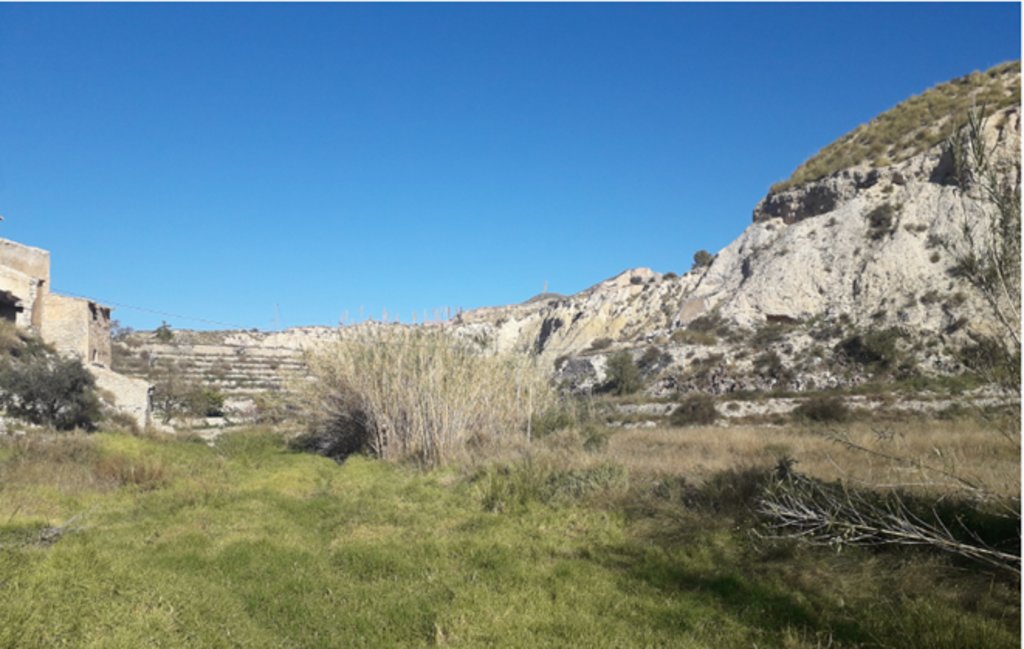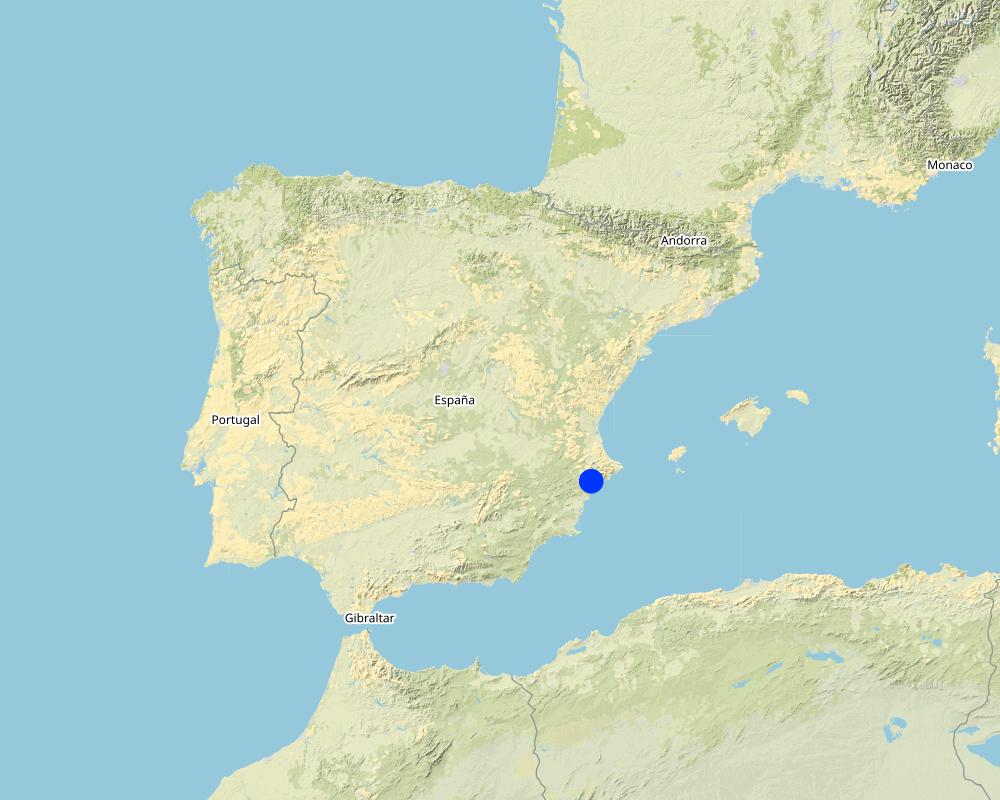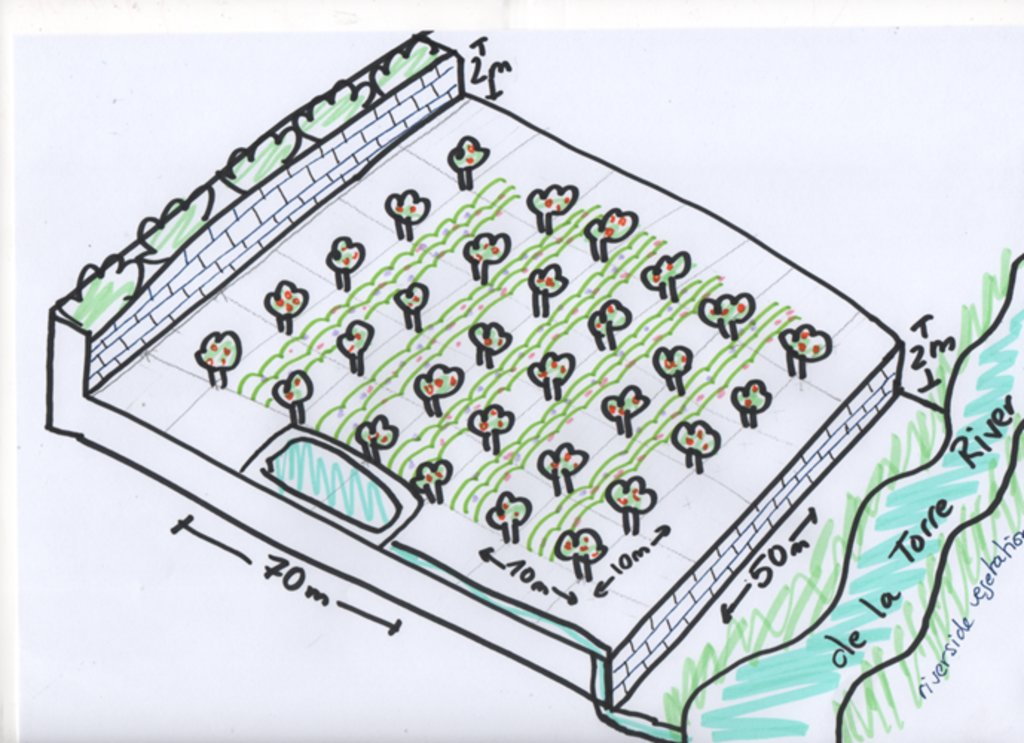Intercropping of orange orchard with vegetables in southern Spain [Spain]
- Creation:
- Update:
- Compiler: Alicia Morugán-Coronado
- Editor: –
- Reviewers: William Critchley, Rima Mekdaschi Studer
Huerto en rotación asociado a un cultivo de naranjos
technologies_6441 - Spain
View sections
Expand all Collapse all1. General information
1.2 Contact details of resource persons and institutions involved in the assessment and documentation of the Technology
Key resource person(s)
land user:
Gosalbez Monllor Celia
Spain
1.3 Conditions regarding the use of data documented through WOCAT
The compiler and key resource person(s) accept the conditions regarding the use of data documented through WOCAT:
Yes
1.4 Declaration on sustainability of the described Technology
Is the Technology described here problematic with regard to land degradation, so that it cannot be declared a sustainable land management technology?
No
2. Description of the SLM Technology
2.1 Short description of the Technology
Definition of the Technology:
Intercropping in an orange trees orchard with no fertilization: Xixona, Alicante (Spain)
2.2 Detailed description of the Technology
Description:
This technology is applied in a 40-year-old orange orchard located in Xixona, Alicante (Spain), near to the de la Torre River. It is within the municipality of Jijona, Alicante province, south of the urban area. The 0.2 ha farm is dedicated to home consumption, with a permanent orchard based on fruit trees, predominantly citrus, with other horticultural crops depending on the season, irrigated by water from the de la Torre River. The orange orchard has recently been expanded by the acquisition of orange tree seedlings (budlings) in 2000, which have added to the established, mature, twenty trees. The management of the plantation in the last 20 years, after a change of ownership, has been as follows. Ploughing to the depth of 20 cm with a motorized tiller to remove weeds, 2-3 times a year, keeping the plant material on the surface as a mulching cover. Flood irrigation is practiced in the orchard for both the citrus and the vegetables. Pest control avoids artificial pesticides and fungicides – with pests being prevented by encouraging the presence of natural predators. There are traps against the fruit fly (Ceratitis capitata), and an insect sticky trap has also been put to use. In recent years, there has been no fertilization of the orchard (the farmer believes it not to be necessary at present), although traditionally (before 2000) the manure from goats installed on the farm was used. In the main plot, between rows of orange trees, there are plant frames (10 x 10 m each) which are used for vegetables crops (lettuce, potatoes, fava beans, spinach, etc) in a crop rotation system (2 cycles per year). During a one-year cycle, annual crops are changed in rotational cycles: lettuce in summer, beans in winter. The main purpose of this technology is the improvement of soil structure and the organic matter content of the soil, while also preventing soil erosion from surface runoff. Using mulch from prunings or weed material has been a main route for improving soil organic matter, soil nutrient status and to prevent soil depletion by erosion. Carbon sequestration has been ensured by permanent green cover in the intercropping system. The land users are improving the technology continuously: minimizing the impact on the agro-ecosystem by avoiding the use of pesticides, intercropping and following a crop rotation.
2.3 Photos of the Technology
2.5 Country/ region/ locations where the Technology has been applied and which are covered by this assessment
Country:
Spain
Region/ State/ Province:
Alicante
Further specification of location:
Xixona
Specify the spread of the Technology:
- applied at specific points/ concentrated on a small area
Is/are the technology site(s) located in a permanently protected area?
No
Map
×2.6 Date of implementation
Indicate year of implementation:
2000
2.7 Introduction of the Technology
Specify how the Technology was introduced:
- through land users' innovation
- as part of a traditional system (> 50 years)
3. Classification of the SLM Technology
3.1 Main purpose(s) of the Technology
- improve production
- reduce, prevent, restore land degradation
- reduce risk of disasters
- adapt to climate change/ extremes and its impacts
- mitigate climate change and its impacts
3.2 Current land use type(s) where the Technology is applied
Land use mixed within the same land unit:
No

Cropland
- Annual cropping
- Perennial (non-woody) cropping
- Tree and shrub cropping
Number of growing seasons per year:
- 2
Specify:
Summer/Winter
Is intercropping practiced?
Yes
3.3 Has land use changed due to the implementation of the Technology?
Has land use changed due to the implementation of the Technology?
- No (Continue with question 3.4)
3.4 Water supply
Water supply for the land on which the Technology is applied:
- mixed rainfed-irrigated
3.5 SLM group to which the Technology belongs
- rotational systems (crop rotation, fallows, shifting cultivation)
- improved ground/ vegetation cover
- integrated pest and disease management (incl. organic agriculture)
3.6 SLM measures comprising the Technology

agronomic measures
- A1: Vegetation/ soil cover
- A6: Residue management

vegetative measures
- V1: Tree and shrub cover
- V3: Clearing of vegetation

structural measures
- S2: Bunds, banks

management measures
- M5: Control/ change of species composition
3.7 Main types of land degradation addressed by the Technology

soil erosion by water
- Wt: loss of topsoil/ surface erosion
- Wg: gully erosion/ gullying

chemical soil deterioration
- Cn: fertility decline and reduced organic matter content (not caused by erosion)

physical soil deterioration
- Pc: compaction
3.8 Prevention, reduction, or restoration of land degradation
Specify the goal of the Technology with regard to land degradation:
- prevent land degradation
- reduce land degradation
4. Technical specifications, implementation activities, inputs, and costs
4.1 Technical drawing of the Technology
Technical specifications (related to technical drawing):
A 0.2ha Orange tree orchard (framing plantation 10x10 m) and interplots with vegetables crops (lettuce, potatoes, fava beans, spinach etc) in a crop rotation system (2 cycles per year). The subplots are between orange fruit trees lines in an intercropping system. Irrigation is carried out with a water from de la Torre river which is near to the field, the water is stored in a basin and the irrigation is by flood, secondary channel from the main water channel (15th century water network). none of the land was fertilized since 2000.
Author:
Alicia Morugan-Coronado
Date:
13/04/2022
4.2 General information regarding the calculation of inputs and costs
Specify how costs and inputs were calculated:
- per Technology area
other/ national currency (specify):
euro
If relevant, indicate exchange rate from USD to local currency (e.g. 1 USD = 79.9 Brazilian Real): 1 USD =:
0.99
4.3 Establishment activities
| Activity | Timing (season) | |
|---|---|---|
| 1. | Soil preparation | winter |
| 2. | Orange tree plantation | winter |
| 3. | Vegetables plantation | winter |
| 4. | Water irrigation | winter |
4.4 Costs and inputs needed for establishment
| Specify input | Unit | Quantity | Costs per Unit | Total costs per input | % of costs borne by land users | |
|---|---|---|---|---|---|---|
| Labour | soil preparation | 1 | 1.0 | 10.0 | 10.0 | 100.0 |
| Labour | orange tree plantation | 25 | 1.0 | 10.0 | 10.0 | 100.0 |
| Labour | Water Irrigation | 1 | 50.0 | 1.0 | 50.0 | 100.0 |
| Labour | vegetables plantation | 1 | 1.0 | 10.0 | 10.0 | 100.0 |
| Equipment | Hoe | 1 | 1.0 | 10.0 | 10.0 | 100.0 |
| Equipment | shovel | 1 | 1.0 | 15.0 | 15.0 | 100.0 |
| Plant material | Orange tree | 1 | 20.0 | 15.0 | 300.0 | 100.0 |
| Plant material | Plants | 1 | 25.0 | 2.0 | 50.0 | 100.0 |
| Plant material | seeds | 1 | 50.0 | 1.0 | 50.0 | 100.0 |
| Total costs for establishment of the Technology | 505.0 | |||||
| Total costs for establishment of the Technology in USD | 510.1 | |||||
4.5 Maintenance/ recurrent activities
| Activity | Timing/ frequency | |
|---|---|---|
| 1. | soil preparation | Winter |
| 2. | orange tree re-plantation | 1 time per year |
| 3. | Water Irrigation | 1 time per year |
| 4. | vegetables plantation | 1 time per year |
| 5. | Weeding | few times per year |
| 6. | Harvesting oranges | 1 time per year |
| 7. | Harvesting vegetables | 2 times per year or vegetable cycle |
| 8. | Prunning | 1 time per year |
4.6 Costs and inputs needed for maintenance/ recurrent activities (per year)
| Specify input | Unit | Quantity | Costs per Unit | Total costs per input | % of costs borne by land users | |
|---|---|---|---|---|---|---|
| Labour | soil preparation | 1 | 1.0 | 10.0 | 10.0 | 100.0 |
| Labour | Harvesting vegetables | 1 | 1.0 | 10.0 | 10.0 | 100.0 |
| Labour | Water Irrigation | 1 | 50.0 | 1.0 | 50.0 | 100.0 |
| Equipment | Hoe | 1 | 1.0 | 10.0 | 10.0 | 100.0 |
| Plant material | vegetables plantation | 1 | 2.0 | 10.0 | 20.0 | 100.0 |
| Plant material | seeds | 1 | 20.0 | 1.0 | 20.0 | 100.0 |
| Plant material | orange tree | 25 | 1.0 | 10.0 | 10.0 | 100.0 |
| Plant material | vegetables plant | 1 | 25.0 | 2.0 | 50.0 | 100.0 |
| Fertilizers and biocides | Prunning | |||||
| Other | Weeding | 1 | 4.0 | 10.0 | 40.0 | 100.0 |
| Total costs for maintenance of the Technology | 220.0 | |||||
| Total costs for maintenance of the Technology in USD | 222.22 | |||||
5. Natural and human environment
5.1 Climate
Annual rainfall
- < 250 mm
- 251-500 mm
- 501-750 mm
- 751-1,000 mm
- 1,001-1,500 mm
- 1,501-2,000 mm
- 2,001-3,000 mm
- 3,001-4,000 mm
- > 4,000 mm
Specify average annual rainfall (if known), in mm:
400.00
Specifications/ comments on rainfall:
The climate of the area is defined as semi-arid Mediterranean, since the average rainfall barely exceeds 400 mm per year, with an average temperature of 16.4ºC. As in the rest of the Mediterranean area, rainfall is concentrated during the months of September and October in periods of torrential rain.
Agro-climatic zone
- semi-arid
5.2 Topography
Slopes on average:
- flat (0-2%)
- gentle (3-5%)
- moderate (6-10%)
- rolling (11-15%)
- hilly (16-30%)
- steep (31-60%)
- very steep (>60%)
Landforms:
- plateau/plains
- ridges
- mountain slopes
- hill slopes
- footslopes
- valley floors
Altitudinal zone:
- 0-100 m a.s.l.
- 101-500 m a.s.l.
- 501-1,000 m a.s.l.
- 1,001-1,500 m a.s.l.
- 1,501-2,000 m a.s.l.
- 2,001-2,500 m a.s.l.
- 2,501-3,000 m a.s.l.
- 3,001-4,000 m a.s.l.
- > 4,000 m a.s.l.
Indicate if the Technology is specifically applied in:
- not relevant
Comments and further specifications on topography:
It is flat terrain, approximately 1% slope.
5.3 Soils
Soil depth on average:
- very shallow (0-20 cm)
- shallow (21-50 cm)
- moderately deep (51-80 cm)
- deep (81-120 cm)
- very deep (> 120 cm)
Soil texture (topsoil):
- fine/ heavy (clay)
Soil texture (> 20 cm below surface):
- fine/ heavy (clay)
Topsoil organic matter:
- low (<1%)
5.4 Water availability and quality
Ground water table:
< 5 m
Availability of surface water:
good
Water quality (untreated):
good drinking water
Water quality refers to:
surface water
Is water salinity a problem?
No
Is flooding of the area occurring?
Yes
Regularity:
episodically
5.5 Biodiversity
Species diversity:
- medium
Habitat diversity:
- low
5.6 Characteristics of land users applying the Technology
Sedentary or nomadic:
- Sedentary
Market orientation of production system:
- subsistence (self-supply)
Off-farm income:
- > 50% of all income
Relative level of wealth:
- average
Individuals or groups:
- individual/ household
Level of mechanization:
- manual work
Gender:
- women
Age of land users:
- middle-aged
Indicate other relevant characteristics of the land users:
It comprises a family with 3 members of different ages, the oldest is 70 years-old and the youngest 40 years-old
5.7 Average area of land used by land users applying the Technology
- < 0.5 ha
- 0.5-1 ha
- 1-2 ha
- 2-5 ha
- 5-15 ha
- 15-50 ha
- 50-100 ha
- 100-500 ha
- 500-1,000 ha
- 1,000-10,000 ha
- > 10,000 ha
Is this considered small-, medium- or large-scale (referring to local context)?
- small-scale
Comments:
0.2 ha
5.8 Land ownership, land use rights, and water use rights
Land ownership:
- individual, titled
Land use rights:
- individual
Water use rights:
- individual
Are land use rights based on a traditional legal system?
Yes
5.9 Access to services and infrastructure
health:
- poor
- moderate
- good
education:
- poor
- moderate
- good
technical assistance:
- poor
- moderate
- good
employment (e.g. off-farm):
- poor
- moderate
- good
markets:
- poor
- moderate
- good
energy:
- poor
- moderate
- good
roads and transport:
- poor
- moderate
- good
drinking water and sanitation:
- poor
- moderate
- good
financial services:
- poor
- moderate
- good
6. Impacts and concluding statements
6.1 On-site impacts the Technology has shown
Socio-economic impacts
Production
crop production
Comments/ specify:
a slight improvement was observed in crop production by the land user
crop quality
Comments/ specify:
a slight improvement was observed in crop quality by the land user
Socio-cultural impacts
food security/ self-sufficiency
Comments/ specify:
The user and its family self-consumed the vegetables harvested from the orchard
health situation
Comments/ specify:
Because of the no pesticides used in this orchard, the health risks decreases
recreational opportunities
Comments/ specify:
All the family cooperate during the harvest in a family tradition
SLM/ land degradation knowledge
Comments/ specify:
The user improves its knowledge with the experience gained annually
Ecological impacts
Water cycle/ runoff
surface runoff
Comments/ specify:
WIth the permanent green cover, the surface runoff decreases
Soil
soil moisture
Comments/ specify:
The intercropping system between fruit trees rows increased the soil moisture
soil cover
Comments/ specify:
The intercropping system between fruit trees rows increased the soil cover
soil loss
Comments/ specify:
The intercropping system between fruit trees rows decreased the soil erosion
soil accumulation
Comments/ specify:
The intercropping system between fruit trees rows increased the soil formation and structure
soil crusting/ sealing
Comments/ specify:
The intercropping system between fruit trees rows decreased the soil
soil compaction
Comments/ specify:
The intercropping system between fruit trees rows decreased the soil compactation
nutrient cycling/ recharge
Comments/ specify:
The intercropping system between fruit trees rows increased the soil nutrients
soil organic matter/ below ground C
Comments/ specify:
The intercropping system between fruit trees rows increased the soilorganic matter
Biodiversity: vegetation, animals
Vegetation cover
Comments/ specify:
The permanent green cover between fruti trees rows increased vegetation cover
biomass/ above ground C
Comments/ specify:
The intercropping system between fruit trees rows increased the soil biomass
plant diversity
Comments/ specify:
The intercropping system between fruit trees rows increased the plant diversity on the orchard
Climate and disaster risk reduction
flood impacts
landslides/ debris flows
6.2 Off-site impacts the Technology has shown
reliable and stable stream flows in dry season
buffering/ filtering capacity
6.3 Exposure and sensitivity of the Technology to gradual climate change and climate-related extremes/ disasters (as perceived by land users)
Gradual climate change
Gradual climate change
| Season | increase or decrease | How does the Technology cope with it? | |
|---|---|---|---|
| annual temperature | increase | moderately | |
| annual rainfall | increase | well | |
| seasonal rainfall | autumn | increase | well |
Climate-related extremes (disasters)
Meteorological disasters
| How does the Technology cope with it? | |
|---|---|
| local rainstorm | well |
| local hailstorm | well |
Climatological disasters
| How does the Technology cope with it? | |
|---|---|
| heatwave | well |
| cold wave | very well |
| drought | well |
Hydrological disasters
| How does the Technology cope with it? | |
|---|---|
| general (river) flood | well |
| flash flood | well |
6.4 Cost-benefit analysis
How do the benefits compare with the establishment costs (from land users’ perspective)?
Short-term returns:
slightly positive
Long-term returns:
very positive
How do the benefits compare with the maintenance/ recurrent costs (from land users' perspective)?
Short-term returns:
slightly positive
Long-term returns:
slightly positive
6.5 Adoption of the Technology
- single cases/ experimental
If available, quantify (no. of households and/ or area covered):
1 family
Of all those who have adopted the Technology, how many did so spontaneously, i.e. without receiving any material incentives/ payments?
- 0-10%
6.6 Adaptation
Has the Technology been modified recently to adapt to changing conditions?
No
6.7 Strengths/ advantages/ opportunities of the Technology
| Strengths/ advantages/ opportunities in the land user’s view |
|---|
| local farm vegetables |
| Eating healthily |
| Saving money in vegetables and fruit orchards |
| Eating your own grow food |
| Strengths/ advantages/ opportunities in the compiler’s or other key resource person’s view |
|---|
| Improvement in soil structure and minimizing soil compactation |
| Improvement in organic matter content |
| Controlling water erosion on surface |
| Maintaining soil surface with permanent green cover |
6.8 Weaknesses/ disadvantages/ risks of the Technology and ways of overcoming them
| Weaknesses/ disadvantages/ risks in the land user’s view | How can they be overcome? |
|---|---|
| Manual work in terrain preparation | Family help on weekends |
| Pest control manual | Try new methods or assessing the correct moment to do the control |
| Controlling spontaneus plants manually | Diversify orchard to minimize the presence of weeds |
| Prunning vegetables manually | Family help on harvest season |
| Weaknesses/ disadvantages/ risks in the compiler’s or other key resource person’s view | How can they be overcome? |
|---|---|
| Inicial preparation of terrain | Overgone by saving cost in annual crop yield |
| Improving knowledgement in crop diversification | Giving technical advisor from experts |
| Problems in pest corntol | Improving the presence of beneficial insects or predators |
7. References and links
7.1 Methods/ sources of information
- field visits, field surveys
1 field visit
- interviews with land users
5 land user interviews
- compilation from reports and other existing documentation
When were the data compiled (in the field)?
09/04/2022
Comments:
One in situ interview (13 April 2022) and the rest of info was compiled by phone with the land user
7.2 References to available publications
Title, author, year, ISBN:
López, J.D, El río Monnegre (Alicante). (2011) Un espacio singular. Revista El Ecologista n.º 68
Title, author, year, ISBN:
Rodà i de Llanza, F., P. i V. Joan. «L’ecologia del paisatge: un nou marc de treball per a la ciència de la conservació». Butlletí de la Institució Catalana d’Història Natural, febrero de 2004, p. 5-20,.
Available from where? Costs?
https://www.raco.cat/index.php/ButlletiICHN/article/view/163310; https://www.todostuslibros.com/libros/los-regadios-historicos-espanoles_978-84-491-1000-9
7.3 Links to relevant online information
Title/ description:
Institut Cartogràfic Valencià
URL:
http://www.icv.gva.es/es
Title/ description:
Sistema de Información Geográfica de parcelas Agrícolas
URL:
https://www.mapa.gob.es/es/agricultura/temas/sistema-de-informacion-geografica-de-parcelasagricolas- sigpac-/default.aspx
Links and modules
Expand all Collapse allLinks
No links
Modules
No modules


